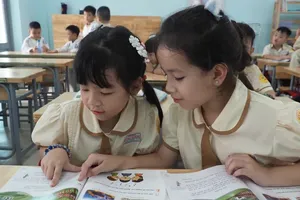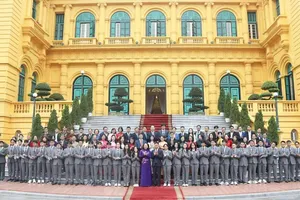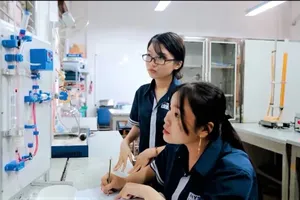 |
A school in Soc Trang is preparing for the new academic year |
Dropping out of high school has long been viewed as a serious educational problem. Ngoc Chanh Commune - a remote commune of the Mekong Delta Province of Ca Mau - has a high rate of dropouts in recent years. To raise the number of children to go to schools in the new school year, from the beginning of July 2023, staff of the local education sector and their peers of social organizations have visited each household to encourage parents to send their children to schools.
Teacher Tran Huyen Tran, in charge of teaching at Hiep Hoa school, said that although teachers have visited a family three times, parents have not decided to send their children to class blaming them for home-to-school distance. Moreover, teacher Huyen Tran is most worried about the lack of classrooms while existing classrooms are severely degraded and have not been maintained or repaired.
Head of the Department of Education and Training in Ca Mau Province’s Dam Doi District Vo Loi said that due to the interlaced river conditions and difficult travel in the region, 94 schools in the district including 48 kindergartens and 46 primary schools are built in remote districts.
He added that without these educational facilities, it will be difficult to mobilize students to go to school. However, the education sector is having difficulty in investing in facilities and equipment for teaching and learning plus a shortage of teachers in these institutions.
The local education sector has proposed the government to remove its difficulties but there has been so far no radical solution.
According to the plan, in the school year 2023-2024, the Mekong Delta Province of Kien Giang has more than 10,000 classes with over 300,000 students from preschools to high schools. Director of the Department of Education and Training of Kien Giang Province Tran Quang Bao moaned that the province continues to lack more than 1,000 teachers in the school year 2023-2024.
The shortage of teachers is the same in the previous school year and the years before that without a radical solution. Specifically, remote and island districts such as An Minh, An Bien, U Minh, and Phu Quoc City of the Mekong Delta Province of Kien Giang have experienced a severe shortage of teachers; for instance, Phu Quoc City lacks about 300 teacher staff.
Deputy Director of the Department of Education and Training of Ca Mau Province Le Hoang Du informed that in the past time, the province has made great efforts to implement the project on arrangement and development of the school network in the area in the period of 2020-2025 with a vision towards 2030.
However, after three years of implementation, the project has not been effective. Currently, several inadequacies are still existing in the education-training sector in the province. Specifically, most schools that teach 2 shifts a day still lack classrooms. The number of students is large but it sees a lack of places for students to take a nap, lack of toilet facilities, bathrooms, clean water, kitchen, and dining room.
According to Director of Kien Giang Department of Education and Training Tran Quang Bao, to solve the shortage of teachers in the locality, the department has advised the provincial People's Committee to develop a scheme to transfer teachers from places having many teachers to places which are short of teachers until 2025. There will be support policies and regimes for teachers who have to move away from their place of residence.
Statistics from the Ministry of Education and Training show that in the Mekong Delta, there are more than 92,900 classrooms of preschools and public high schools but the percentage of permanent classrooms is only about 81.5 percent. In particular, more than 1,270 classrooms in areas with extremely difficult economic and social conditions are located in other facilities.
























